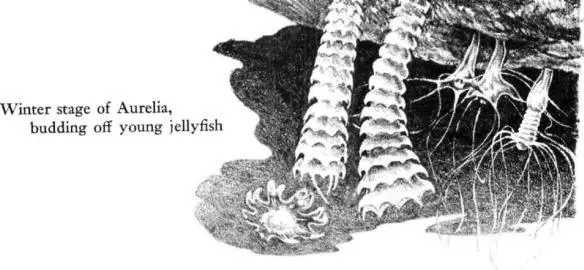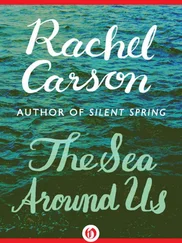Curious about the early stages of this abundant snail, I have gone down into my own rockweed forests on the summer low tides to search for them. Sorting over the prostrate wrack, examining its long strands for some signs of what I sought, I have occasionally been rewarded by discovering transparent masses of a substance like tough jelly, tightly adhering to the fronds. They averaged perhaps a quarter-inch long and half as wide. Within each mass 1 could see the eggs, round as bubbles, dozens of them embedded in the confining matrix. One such egg mass that I carried to the microscope contained a developing embryo within the membranes of each egg. They were clearly molluscan, but so undifferentiated that I could not have said what mollusk lay nascent within. In the cold waters of its home, about a month would intervene from the egg to the hatching stage, but in the warmer temperatures of the laboratory the remaining days of development were reduced to hours. The following day each sphere contained a tiny baby periwinkle, its shell completely formed, apparently ready to emerge and take up its life on the rocks. How do they hold their places there, I wondered, as the weeds sway in the tides and occasional storms send waves pounding in over the shore? Later in the summer there was at least a partial answer. I noticed that many of the air vesicles of the wracks bore little perforations, as though they had been chewed or punctured by some animal. I slit some of these vesicles carefully so that I might look inside. There, secure in a green-walled chamber, were the babies of the smooth periwinkle—from two to half a dozen of them sharing the refuge of a single vesicle, secure alike against storms and enemies.

Down near the low water of the neap tides the hydroid Clava spreads its velvet patches on the fronds of the knotted wrack and the bladder wrack. Rising from its point of attachment like a plant from its root clump, each cluster of tubular animals looks like nothing so much as a spray of delicate flowers, shading from pink to rose and fringed with petal-like tentacles, all nodding in the water currents as woodland flowers nod in a gentle wind. But the swaying movements are purposive ones by which the hydroid reaches into the currents for food. In its way it is a voracious little jungle beast, all its tentacles studded with batteries of stinging cells that can be shot into its victims like poisoned arrows. When, in their ceaseless movements, the tentacles come into contact with a small crustacean or worm or the larva of some sea creature, a shower of darts is released; the prey animal becomes paralyzed and is seized and conveyed to the mouth by the tentacles.
Each of these colonies now established on the wracks came from a little swimming larva that once settled there, shed the hairy cilia by which it swam, attached itself, and began to elongate into a little plantlike being. A crown of tentacles formed at its free end. In time, from the base of the tubular creature, a seeming root, or stolon, began to creep over the rockweed, budding off new tubes, each complete with mouth and tentacles. So all the numerous individuals of the colony originated in a single fertilized ovum that yielded the wandering larva.
In season, the plantlike hydroid must reproduce, but by a strange circumstance it cannot itself yield the germ cells that would give rise to new larvae, for it can reproduce only non-sexually, by budding. So there is a curious alternation of generations, found again and again in many members of the large coelenterate group to which the hydroids belong, by which no individual produces offspring that resemble itself, but each is like the grandparental generation. Just below the tentacles of an individual Clava the buds of the new generation are produced—the alternate generation that intervenes between colonies of hydroids. They are pendent clusters shaped like berries. In some species the berries, or medusa buds, would drop from the parent and swim away—tiny, bell-shaped things like minute jellyfish. Clava, however, does not release its medusae but keeps them attached. Pink buds are male medusae; purple ones are female. When they are mature, each sheds its eggs or sperm into the sea. When fertilized, the eggs begin to divide and through their development yield the little protoplasmic threads of larvae, which swim off through unknown waters to found some distant colonies.
During many days of midsummer, the incoming tides bring the round opalescent forms of the moon jellies. Most of these are in the weakened condition that accompanies the fulfillment of their life cycle; their tissues are easily torn by the slightest turbulence of water, and when the tide carries them in over the rockweeds and then withdraws, leaving them there like crumpled cellophane, they seldom survive the tidal interval.
Each year they come, sometimes only a few at a time, sometimes in immense numbers. Drifting shoreward, their silent approach is unheralded even by the cries of sea birds, who have no interest in the jellyfish as food, for their tissues are largely water.

During much of the summer they have been drifting offshore, white gleams in the water, sometimes assembling in hundreds along the line of meeting of two currents, where they trace winding lines in the sea along these otherwise invisible boundaries. But toward autumn, nearing the end of life, the moon jellies offer no resistance to the tidal currents, and almost every flood tide brings them in to the shore. At this season the adults are carrying the developing larvae, holding them in the flaps of tissue that hang from the under surface of the disc. The young are little pear-shaped creatures; when finally they are shaken loose from the parent (or freed by the stranding of the parent on the shore), they swim about in the shallow water, sometimes swarms of them together. Finally they seek bottom and each becomes attached by the end that was foremost when it swam. As a tiny plantlike growth, about an eighth of an inch high and bearing long tentacles, this strange child of the delicate moon jelly survives the winter storms. Then constrictions begin to encircle its body, so that it comes to resemble a pile of saucers. In the spring these “saucers” free themselves one after another and swim away, each a tiny jellyfish, fulfilling the alternation of the generations. North of Cape Cod these young grow to their full diameter of six to ten inches by July; they mature and produce eggs and sperm cells by late July or August; and in August and September they begin to yield the larvae that will become the attached generation. By the end of October all of the season’s jellyfish have been destroyed by storms, but their offspring survive, attached to the rocks near the low-tide line or on nearby bottoms offshore.

If the moon jellies are symbols of the coastal waters, seldom straying more than a few miles offshore, it is otherwise with the great red jellyfish, Cyanea, which in its periodic invasions of bays and harbors links the shallow green waters with the bright distances of the open sea. On fishing banks a hundred or more miles offshore one may see its immense bulk drifting at the surface as it swims lazily, its tentacles sometimes trailing for fifty feet or more. These tentacles spell danger for almost all sea creatures in their path and even for human beings, so powerful is the sting. Yet young cod, haddock, and sometimes other fishes adopt the great jellyfish as a “nurse,” traveling through the shelterless sea under the protection of this large creature and somehow unharmed by the nettle-like stings of the tentacles.
Читать дальше















